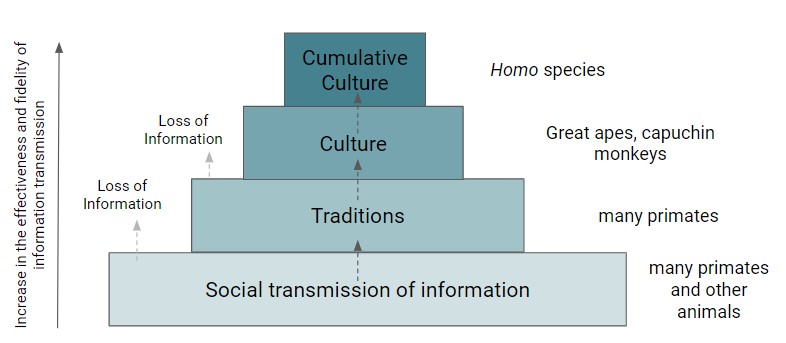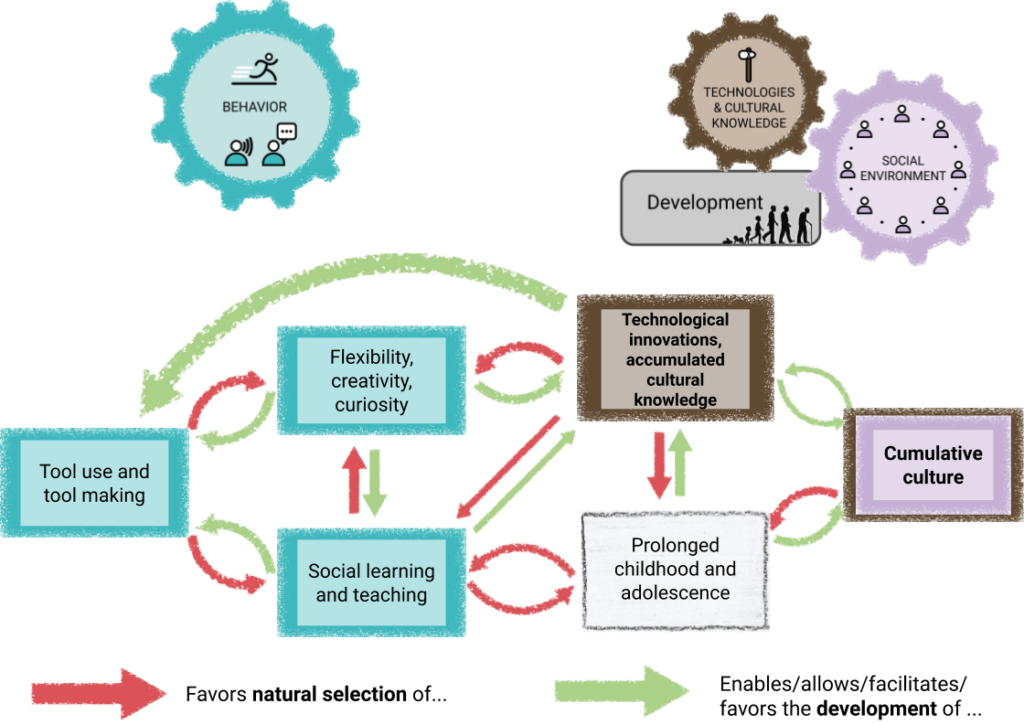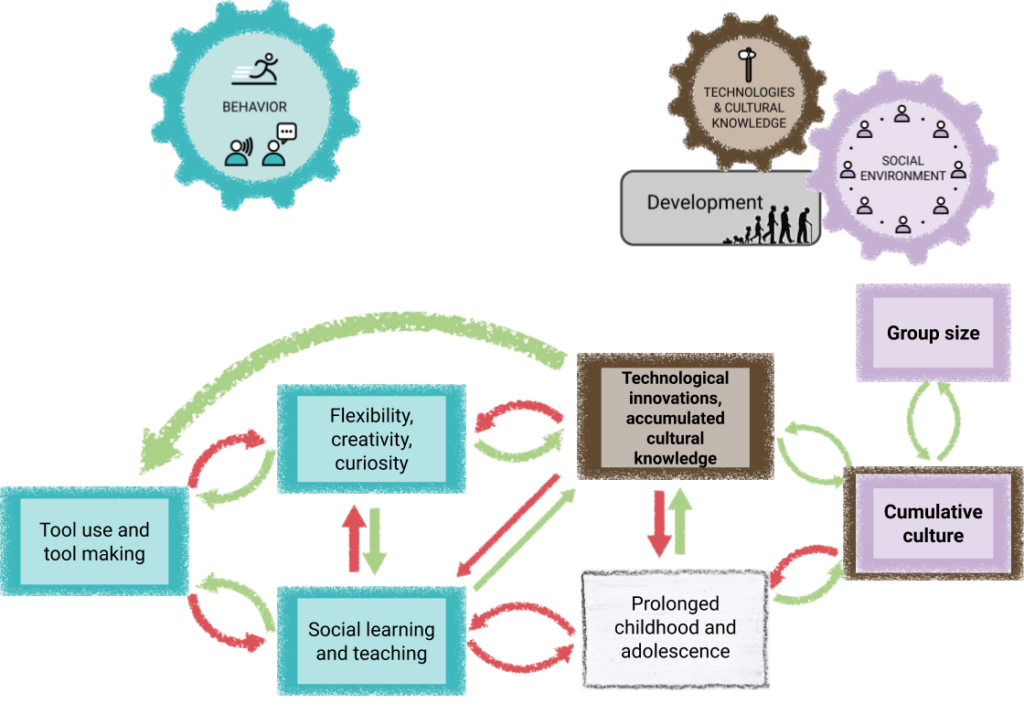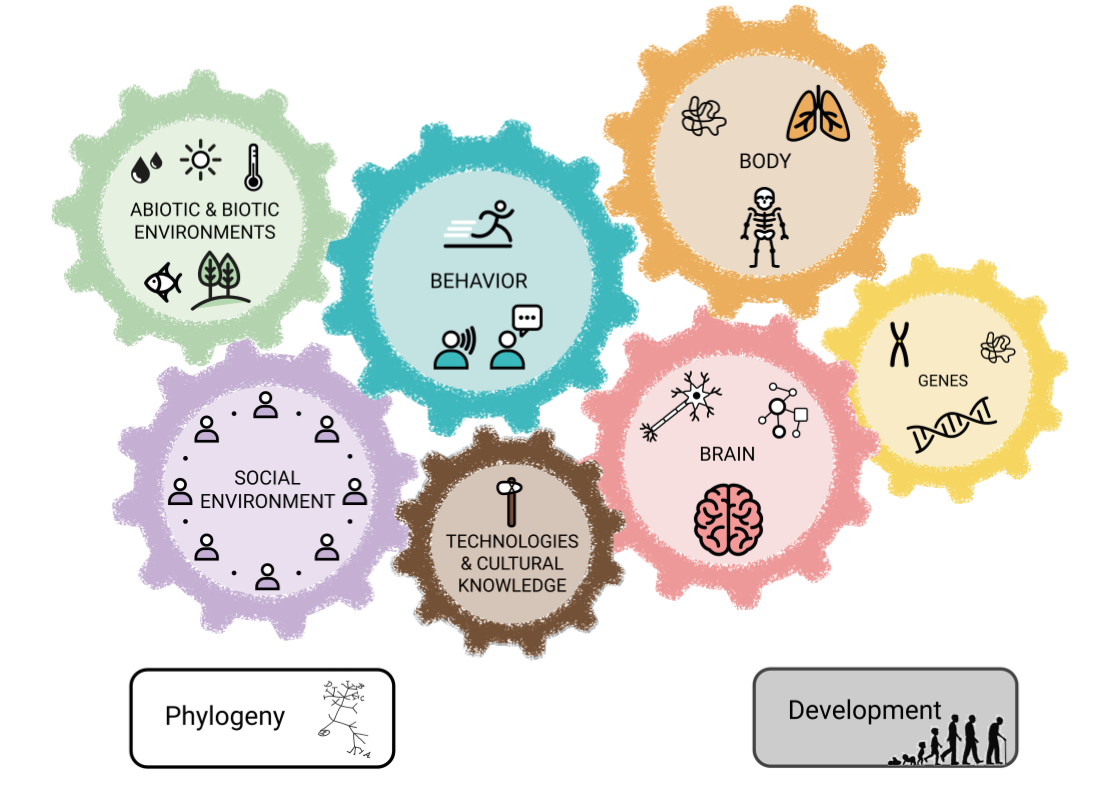Cumulative Culture
Physicist Isaac Newton once said of the importance of his scientific accomplishments: “I could only look so far because I was standing on the shoulders of giants.” By that he meant that he was relying strongly on the knowledge of his predecessors, and only by doing so could get to his own findings.
Consider for yourself how many things you use in your everyday life – how you live, how you move, how you communicate with others, what you eat – and how much knowledge you have accumulated in the course of your life. How easy would it be for you to make these things yourself through independent learning, or to acquire this knowledge only through your own observations and experiences?
Even the manufacture of a seemingly simple thing like a pencil would be impossible for us without any further cultural technology, or could only be done by a massive expenditure of time and energy. Even something as simple as a cloud, without access to the accumulated cultural knowledge of the generations before us, would be a strange creature living in the sky. Maybe our own lifetime would not be enough until we finally made a single pencil. Surely, from our own daily observations, we would hardly realize that clouds are made of water vapor.
So a peculiarity of human culture seems to be that a person born today could not invent many of the important technologies during her own life and could not acquire all the cultural knowledge through her own experience alone. Based on this fact, anthropologists distinguish human culture from the culture of other species. They call this form of culture cumulative culture, from the Latin cumulare, which means to “accumulate”, “pile up”.
Anthropologists think that the cumulative culture of humans is made possible because of an increased capacity for social learning and teaching in our species, which was made more efficient and effective through the emergence of language, as well as an increased ability to innovate. The natural selection of these traits may have started to increase already 2 Mio years ago with Homo erectus. Furthermore, life in larger and larger groups with division of labor meant that more individuales were present in the social environment that could function as teachers and “cultural information storage”, and that group members could specialize on the learning and teaching of particular skills and other cultural traits. Survival of groups in turn depended more and more on this cultural repertoire, which increased selection pressures on abilities and motivations for social learning and teaching.
Other species, especially primates but also birds, fish, invertebrates, also pass on many behaviors through some form of social learning. However, in our species these skills were especially tuned and elaborated. This allows new ideas, new knowledge, new technologies and behaviors to spread in our populations. Others in the population, in turn, can build on this knowledge and technologies, expand, enhance, and add new things. All this in turn is passed on to everyone in the population, and so on.
However, not all knowledge, technologies or behaviors that appeared in the populations of our ancestors were being passed on and accumulated to the same degree. Some of these things were copied or transmitted more than others, some things disappeard again. This finally leads to cultural evolution.
"We humans are smart because we are cultured, rather than cultured because we are smart."
Cecilia Heyes (2020)

The differences between the traditions and cultures of other animals and the cumulative nature of culture in our species.
Source: adapted from Whiten & van Schaik (2007)
Michael Tomasello (former Director of the Research Group for Comparative and Developmental Psychology at the Max Planck Institute for Evolutionary Anthropology in Leipzig, Germany) talks about the importance of cumulative culture in our species and uses the metaphor of a ratchet.
Cultural evolution researcher Michael Muthukrishna about how innovation happens in human groups. According to him and other cultural evolution scientists, innovation is not so much due to some isolated genius inventor, but rather the result of many humans being connected, learning from each other, exchanging knowledge and tinkering with previous ideas.
How could we test the hypothesis that accumulated cultural knowledge was and is essential in the evolutionary success (survival, reproduction, population growth) of our species? After all, it would be unethical to run an experiment in which we deprive a group of humans of cultural knowledge and then compare them to another group of humans that has been taught a lot of knowledge and skills, to see who survives better and has more offspring in a particular environment.
What we can do is look for “natural experiments” throughout history of human groups being cut off from cultural knowledge that would allow them to survive in a particular environment. Evolutionary anthropologist Joseph Henrich has collected a number of such stories. They indicate that our ability to survive as a species in the many ecosystems of the world is in large part due to the transmission of accumulated cultural knowledge through teaching and learning over the generations.
Another thing we can do is run experiments in the lab. In such “transmission chain” experiments, people have to create artefacts – a tool, a structure, a picture etc. – and improve on them over several “generations” by copying and tinkering with the previous version. A recent study (Derex et al., 2019) found that humans can improve a technology by tinkering with it over several iterations, without really understanding the physics behind it. The scientists think that this indicates that our species’ ability for cumulative culture is not necessarily so much due to our individual understanding or “smartness”, but due to our ability to learn from others and build on previous ideas. Nonetheless, some understanding is probably helpful in order to choose possible improvements that are “most likely” to work and achieve the desired outcome.
Humans Can Improve Technology without Really Understanding It. Small tweaks, not deep physical insight, can lead to a better mousetrap. (Gary Stix, Scientific American, 2019)

Lost explorers
Stories of lost explorers that tell us about the importance of cultural knowledge to our survival.

Reading text: Cumulative culture
A reading text about the importance of cumulative culture in our everyday experience and in the evolution of our species
Causal map on cumulative culture

Reflection questions:
What might be the additional role of group size, or the number of humans interacting, in allowing the transmission and accumlation of cultural knowledge?
Might the capacity for cumulative culture also have an effect on possible group size? In what way?
How could we add the factors “Group size” or “Social network size” to the causal map on cumulative culture?


Causal maps on the evolution of human traits
All causal maps on human evolution in one Google slide file
References
- Boyd, R. T., Richerson, P. J., & Henrich, J. (2011). The cultural niche: Why social learning is essential for human adaptation. Proceedings of the National Academy of Sciences, 108(Supplement_2), 10918–10925. https://doi.org/10.1073/pnas.1100290108
- Chudek, M., & Henrich, J. (2011). Culture-gene coevolution, norm-psychology and the emergence of human prosociality. Trends in Cognitive Sciences, 15(5), 218–226. https://doi.org/10.1016/j.tics.2011.03.003
- Dean, L. G., Vale, G. L., Laland, K. N., Flynn, E., & Kendal, R. L. (2014). Human cumulative culture: A comparative perspective. Biological Reviews, 89(2), 284–301. https://doi.org/10.1111/brv.12053
- Derex, M., Bonnefon, J. F., Boyd, R., & Mesoudi, A. (2019). Causal understanding is not necessary for the improvement of culturally evolving technology. Nature Human Behaviour, 3(5), 446–452. https://doi.org/10.1038/s41562-019-0567-9
- Henrich, J. (2016). The Secret of Our Success. How Culture Is Driving Human Evolution, Domesticating Our Species, and Making Us Smarter. Princeton, Oxford: Princeton University Press.
- Heyes, C. (2020). Culture Primer, PsyArXiv Preprints. https://doi.org/10.31234/osf.io/v8ms3
- Mesoudi, A., & Whiten, A. (2008). The multiple roles of cultural transmission experiments in understanding human cultural evolution. Philosophical Transactions of the Royal Society of London. Series B, Biological Sciences, 363(1509), 3489–3501. https://doi.org/10.1098/rstb.2008.0129
- Muthukrishna, M., & Henrich, J. (2016). Innovation in the Collective Brain. Philosophical Transactions of the Royal Society B: Biological Sciences, 371(1690), 20150192. https://doi.org/10.1098/rstb.2015.0192
- Whiten, A., & van Schaik, C. P. (2007). The evolution of animal “cultures” and social intelligence. Philosophical Transactions of the Royal Society B-Biological Sciences, 362(1480), 603–620. https://doi.org/10.1098/rstb.2006.1998
- Whiten, A., Hinde, R. A., Laland, K. N., & Stringer, C. B. (2011). Culture evolves. Philosophical Transactions of the Royal Society B: Biological Sciences, 366(1567), 938–948. https://doi.org/10.1098/rstb.2010.0372

